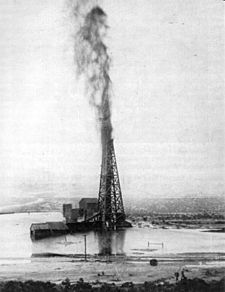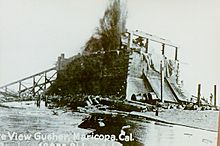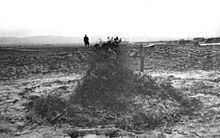Lakeview Gusher facts for kids
Quick facts for kids Lakeview Gusher Number One |
|
|---|---|

The Lakeview gusher with a lake of crude oil surrounding the derrick, mid-1910
|
|
| Location | Kern County, California |
| Coordinates | 35°05′29″N 119°24′05″W / 35.091424°N 119.401377°W |
| Date | 14 March 1910 – September 1911 |
| Cause | |
| Cause | Wellhead blowout |
| Operator | Lakeview Oil Company |
| Spill characteristics | |
| Volume | 9 million barrels (1.4×106 m3) |
| Reference #: | 485 |
The Lakeview Gusher Number One was a huge burst of oil from a well in Kern County, California, in 1910. It became the biggest accidental oil spill ever, lasting for 18 months. During this time, about 9 million barrels of crude oil spilled out.
The Midway-Sunset area had one of the largest oil reserves in the United States. When the Lakeview Oil Company started drilling, they expected to find mostly natural gas and only a little oil. Instead, a massive blowout happened, which was too much for their storage tanks to handle.
This giant geyser of oil released over 1.2 million tons of crude oil. This was far more than any other single oil leak on land or in water. Today, you can find the site about 800 meters (half a mile) east of the Taft–Maricopa Highway. A special sign and a bronze plaque mark it as California Historical Landmark number 485.
How the Lakeview Gusher Started
The Lakeview Oil Company began drilling at its Number One well on January 1, 1909. At first, they only found natural gas. As they continued working, the company teamed up with the Union Oil Company. Union Oil wanted to build storage tanks near the well.
Back in the early 1900s, drilling technology was not as advanced as it is today. There were no modern safety tools like blowout preventers. On March 15, 1910, the drill reached a depth of 2,440 feet (744 meters). Suddenly, highly pressurized oil burst through the well casing above the drill bit.
This was the start of the Lakeview Gusher. An estimated 9 million barrels of oil escaped before the gusher was finally brought under control in September 1911.
Dealing with the Massive Oil Flow
When the gusher first started, about 18,800 barrels of oil flowed out each day. This created a river of crude oil. Crews quickly worked to contain it using makeshift sandbag dams and dikes. At its peak, the oil flow reached an incredible 90,000 barrels per day.
To manage this huge amount of oil, a pipeline was built to carry it to storage tanks 2.5 miles (4 kilometers) away. From there, an 8-inch (20 cm) pipeline led to Port Avila on the coast. Despite all these efforts, less than half of the 9.4 million barrels released over the 544 days of the gusher were saved. The rest either evaporated into the air or soaked into the ground. It was truly amazing that the oil field did not catch fire during this time.
California Historical Landmark
The Lakeview Gusher site is recognized as a California Historical Landmark. The plaque there reads:
- NO. 485 LAKEVIEW GUSHER 1 - America's most spectacular gusher blew in here on March 14, 1910. Initially 18,000 barrels per day, the flow later reached an uncontrolled peak of 100,000 barrels per day, completely destroying the derrick. This Union Oil Company well produced nine million barrels of oil in 18 months.
The marker was officially registered on August 7, 1951.





